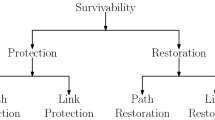Abstract
In this paper, we solve a mapping problem related to supporting two service classes that are differentiated based on their level of protection. The first class of service, called Fully Protected (FP), offers end-users a guarantee of survivability in the case of a single failure; all FP traffic is protected using either a 1:1 or 1 + 1 protection scheme at the WDM layer. The second class of service, called Best-Effort Protected (BEP), is not protected; instead restoration at the IP layer is provided. When a failure occurs, the network restores as much BEP traffic as possible, and thus BEP traffic does not receive any specific guarantees. The FP service class mimics what Internet users receive today. The BEP traffic is designed to run over the large amounts of unused bandwidth that exist in today’s Internet. The motivation of this approach is to give carriers a mechanism for increasing the load carried on backbone networks without reducing the QoS received by existing customers. In order to support two such services, the logical links at the IP layer need to be carefully mapped onto primary and backup paths at the optical layer. We incorporate into our mapping problem a number of practical requirements that reflect constraints that carriers face and policies they want to enforce. For example, we allow the FP demand to be specified via a traffic matrix at the IP layer, we include an overprovisioning factor that specifies the portion of each link that must be left unused, and we incorporate a minimal fairness requirement on how the BEP traffic is allocated among connections. Our goal is to quantify how much BEP traffic can be carried in addition to the FP traffic, without impacting the protection quality of the FP traffic even in the case of failure, and without impacting the FP load. We provide two solutions, one is an optimal solution using an Integer Linear Program (ILP) model, and the other is an algorithm based on the Tabu Search (TS) methodology. Our heuristic algorithm allows us to solve this problem for large networks such as those spanning the continental US. We show that by having two such classes of service, the load on a network can be increased by a factor of 4–7 (depending upon the network). We illustrate that even with overprovisioning and fairness requirements (both of which reduce the total possible BEP load carried), we can still typically triple the total network load. We show that the location of the bottleneck can affect whether or not we see a difference in performance between 1:1 or 1 + 1 protection schemes. Our results illustrate the gain in terms of additional BEP load carried that can be obtained simply due to the upgrade of a single link. Our proposal provides carriers a new vehicle for generating revenue by extracting benefit from all the sources of unused bandwidth in networks.
Similar content being viewed by others
References
P Thiran N Taft C Diot H Zang R MacDonald (2001) A protection-based approach to qos in packet-over-fiber networks. International Workshop on Digital Communications Taormina, Italy
K Papagiannaki S Moom C Fraleigh P Thiran F Tobagi C Diot (2002) Analysis of measured single-hop delay from an operational backbone network IEEE Infocom 2002 New York
A Nucci N Taft P Thiran H Zang C Diot (2002) Increasing the link utilization in ip over wdm networks Proc. Spie OPTICOMM Boston
E Taillard F Glover D De Werra (1993) ArticleTitleA user’s guide to tabu search Annals of Operations Research 41 3–28
O Gerstel R Ramaswami (2000) ArticleTitleOptical layer survivability: A services perspective IEEE Communication Magazine 38 IssueID3 104–113
G. Mohan, A. K. Somani, Routing dependable connections with specified failure restoration guarantees in wdm networks. Proc. Infocom 2000, Jerusalem, April 2000
M Sridharan A. K Somani (2000) Revenue maximization in survivable wdm networks Opticomm Dallas
R Ramamurthy B Mukherjee (1999) Survivable wdm mesh network Proc. Infocom 1999 New York
J. O Crochat J. Y Le Boudec (1998) ArticleTitleDesign protection for wdm optical networks IEEE Journal on Selected Areas in Communication, 16 IssueID7 1158–1165
J. O Crochat J. Y Le Boudec O Gerstel (2000) ArticleTitleProtection interoperability for wdm optical networks IEEE Transaction on Networking, 8 IssueID3 384–395
E. Modiano, A. Narula-Tam, Survivable routing of logical topologies in wdm networks. in Proc. INFOCOM 2001, 1:348–357, Anchorage, April 2001
Bertsekas, Gallager, Algorithm—data networks, vol. 2nd edn (Prentice-Hall, 1992)
Ilog cplex software optimization suite: http://www.ilog.com/products/cplex/
G. L. Nemhauser, A. H. G. Rinnoy Kan, M. J. Todd, Optimization—handbooks in operations research and management science, vol. 1, North-Holland, 1989
Author information
Authors and Affiliations
Rights and permissions
About this article
Cite this article
Nucci, A., Taft, N., Thiran, P. et al. Increasing the Link Utilization in IP over WDM Networks Using Availability as QoS. Photon Netw Commun 9, 55–75 (2005). https://doi.org/10.1007/s11107-005-4531-4
Issue Date:
DOI: https://doi.org/10.1007/s11107-005-4531-4




